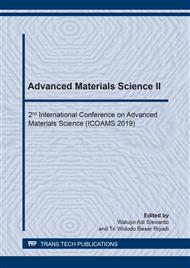p.135
p.144
p.150
p.159
p.166
p.172
p.178
p.185
p.191
Chemical Treatment of Liquid Waste Generated from Leather Tannery Industry by Using Alum as Coagulant Material
Abstract:
The tannery industry generally produces trivalent chromium waste (Cr3 +) and hexavalent chromium (Cr6 +). This waste before being released into the environment must meet quality standards according to KEPMENLH no.51 / MENLH / 10/1995 concerning liquid quality standards for industrial activities which says the maximum total chromium content is 0.6 ppm. This study aims to reduce the levels of Chromium in waste produced by the leather tanning industry by using alum coagulants. This research uses simulation waste which is made based on the results of BPPT analysis of waste in the leather tanning industry in Tangerang city, namely CV "Lengtat Tangerang Leather". The method used in this research is coagulation-flocculation with alum as a coagulant and lime as an alum reaction assistant in the form of hydroxide ions. The parameters observed in this study were the pH adjustment and the ratio of alum mass to lime mass. From the results of the study it was found that the decrease in the best chromium content for Cr + 3 occurred at a ratio of 5 and pH 8.2 which resulted in a chromium content of 0.0076 ppm with a decrease in percentage of 99.95%. As for the Cr6 + test, at a ratio of 3 and pH 6.4 the chromium content showed a value of 0.4110 ppm. The lowest chromium level occurs at a ratio of 5 and pH of 5.8 which results in a chromium level of 0.3341 ppm with a decrease percentage of 56.61%.
Info:
Periodical:
Pages:
178-184
Citation:
Online since:
May 2020
Authors:
Price:
Сopyright:
© 2020 Trans Tech Publications Ltd. All Rights Reserved
Share:
Citation:


